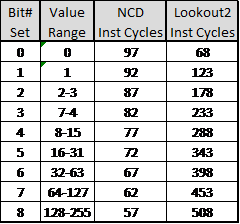For those who are curios as to the testing results of NCD vs. Lookdown2 in the context of this discussion.
I ran the following code in the MPLAB Simulator.
Code:
NCDSUB:
for i = 0 to 255
mystatus = i
''Start MPLAB SIM Stopwatch
mybyte = NCD mystatus
''Stop MPLAB SIM Stopwatch
next i
lcdout $FE,1,"NCD: ", idec mybyte
pause 500
return
LOOKSUB:
for i = 0 to 255
mystatus = i
''Start MPLAB SIM Stopwatch
lookdown2 mystatus, <= [%00000000, %00000001, %00000011, %00000111, %00001111, %00011111, %00111111, %01111111, %11111111], mybyte
''Stop MPLAB SIM Stopwatch
next i
lcdout,1, "Lookdown: ", idec mybyte
pause 500
return
and here are the results.







 . I have never used this command before, but now I can see it's potential.
. I have never used this command before, but now I can see it's potential.


Bookmarks